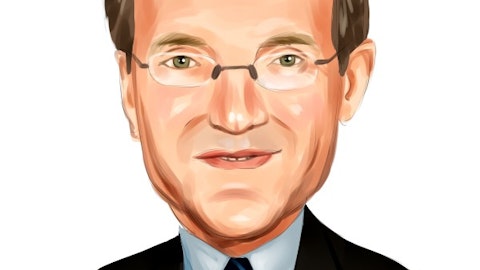Hans Vestberg : On the value segment, in prepaid and TracFone, as we said in the prepared remarks, we are at the low point to first half of ‘23 and from here on, we should start sequentially improving. Secondly, this is really important for our strategy. We want to build the network once and have as many connections as possible and address the entire market on wireless. And, of course, being strong and being the number one in the value segment is important. Then from a market point of view, we all know that there has been some sort of blend between the low end on postpaid and prepaid, which means that the volumes in preparation is little bit lower and we have not been part of that transformation or taking customer for prepaid.
So what we’re doing right now in our own operation, which is a lot, but one, we’re building up Total by Verizon, which is a great speed we have on opening new doors. That’s going to help us to move up to postpaid for the customers that want to do that. But also have an high end value proposition. Secondly, we work with the national retailers that we have to see that we are fortifying our offerings in our store. And finally, you’re seeing that feasible continuous with the pace it has. And that we’re working with a lot of other things. So it’s a lot of ongoing here that gives us confidence that we will sequentially continue to improve. And but clearly, this is very important for our overall strategy.
Michael Rollins: Thanks.
Brady Connor : Brad, we are ready for the next question.
Operator: The next question comes from Bryan Kraft of Deutsche Bank. Your line is open, sir.
Bryan Kraft: Hi, good morning. I have a question on fixed wireless. There continues to be a lot of debate regarding the sustainability of fixed wireless served by macro as all sites given the trajectory of broadband usage and of course, unit economics of radio access networks versus fiber. So really I guess two questions. One, since you started the fixed wireless deployment, have your assumptions changed at all regarding usage or the number of fixed wireless customers you can ultimately load network with over time? And secondly, what developments have occurred in millimeter waves delivered fixed wireless this year? And how at this point are you thinking about millimeter wave evolving over the next couple years as a scalable access technology? Thanks.
Hans Vestberg : Hi, Bryan. And the first, yeah, our assumption has changed on fixed wireless access because our technology has improved more than we thought from the beginning. That means that we can take on even more capacity. And we’re only on the first inning on the software improvements, and our optimization of the network. I think Joe and his team is doing a fantastic job with it. Customers are using it on the consumer side, equally much as on the Fios. So that there’s no different on usage. So I think we have a great path forward with technology and we are not seeing everything we can do still with the fixed wireless access when it comes to software development, radio improvements, et cetera. So I’m – I have no hesitation over the assumption with that made.
They are actually having better assumptions today. When it comes to millimeter wave, that is playing a vital role for us for many reasons. First of all, it takes in all high density areas. They take the majority of the capacity. And that’s very important for several reasons. I unleashed a mid-band spectrum in order to have better performance on the street, but also in fixed wireless access. So millimeter wave will continue to play a very vital role. As we have said several times, we built very few – very quickly in all major places. And now we’re sort of augmenting where we see a lot of traffic. On top of that, of course, we see opportunities for using our millimeter wave also for MDUs over the time to see that we address that market with fixed wireless access.
So, all in all, we still have a lot of technology evolution to see that we can serve even more customers with even better performance and more capacity. So, I’m very happy and as you’ve seen on fixed wireless access, our MPS scores is all out to the shot. I mean the customers loves it. It is easy. It’s quick to deploy itself to install. So I think we hit it clearly with this product and we want to push it with our team and see the customer gets the right products.
Bryan Kraft: Thank you Hans.
Brady Connor : Brad, we are ready for the next question.
Operator: The next question comes from Frank Louthan of Raymond James. Your line is open.
Frank Louthan: Great. Thank you very much. Quick question. I apologize if this was addressed. Can you quantify how much of the interest expense going from capitalization to the income statement from C-band? And then secondly, where are you as far as being able to utilize the fixed wireless to help reduce cost or type two circuits and that’s sort of thing? Thank you.
Hans Vestberg : I can start with the fixed wireless access and Tony will. Yeah, great question. Sometimes we are focused on fixed wireless access being sort of a consumer solution for broadband. Today, we sell a lot of fixed wireless access for – in the business segment as well both for large enterprises and for small and medium customers which has a different usage pattern, which is great. And also we see and Kyle has discussed that several times. He see also, this is a way of optimizing our access cost by having fixed access as a barrier or transport in many cases. So, clearly again, this is how we build our network from the beginning to be able from the datacenter to the edge of the network have a total harmonized network that can fastly move all the data and then at the edge of the network, we’ll have different type of access technologies in order to serve our customers and fixed wireless access can serve many different use cases.
And we, we tend to talk a lot about the consumer fixed wireless access use case. But I have or Kyle have a lot of use cases in the business segment and if you look at the numbers this quarter, he’s continuing to add the lot of fixed wireless access customers, as well.
Tony Skiadas : And then, Frank on the on the capitalized interest question, in the quarter, we saw about $0.03 of pressure from capitalized interest from the time we got the licenses. And then, for the fourth quarter, we estimate $0.03 to $0.04 of pressure from capitalized interest. So hope that helps.
Frank Louthan: All right. Great. Thank you.
Brady Connor : Brad, we are ready for the next question.
Operator: The next question comes from David Barden of Bank of America. Your line is open.





